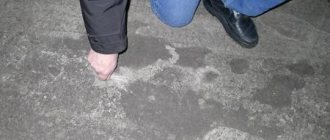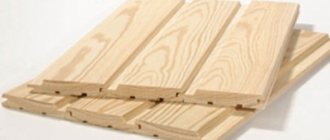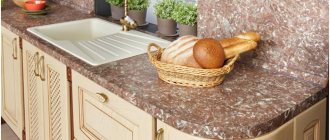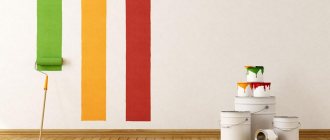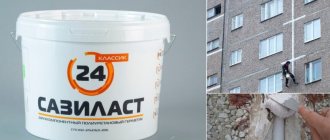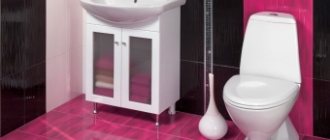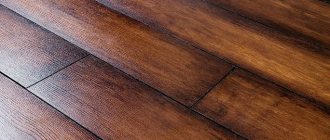The use of any type of tile (tile, porcelain stoneware, natural stone) in interior design poses several difficult challenges for homeowners. The success of the repair depends on their decision. One of these problems is the choice of grout. Opponents may object: “grinding the joints between the tiles is not a problem. This is a normal technological operation." This was the case at the end of the last century. Nowadays the choice of fugue species in composition and color is so large that it is not difficult to get confused. In the end, it may turn out that the best tile grout was somewhere nearby.
The editors of the construction portal StroyGuru decided to figure out how to beautifully seal the seams between tiles with minimal financial investment, while simultaneously protecting the tile adhesive from destructive processes under the influence of unfavorable factors.
What is grout
Anyone who has studied it even a little knows about the richness of the Russian language. The diversity is also confirmed by the morphological analysis of the word grout. Dictionaries give several interpretations:
- flour porridge;
- last plastering operation;
- a special mixture for sealing joints between laid tiles. Another term is sometimes used: "fugue".
We are interested in the latter explanation. A more complete version of the interpretation of the concept is as follows: grout is a whole group of building materials for filling the gaps between tiles.
The essence of the technical process is to fill the free space between the laid cladding with a plastic mass, which is glued to the edges of the tile, after which it hardens during the setting or drying process. As a result, a waterproof partition is formed that protects the tile adhesive from moisture. At the same time, the fugue does not shrink during the hardening process thanks to special additives. No shrinkage, no cracks.
The goal is to completely seal the installation.
Functions
The fugue performs several important functions:
- protects the seams between tiles from moisture and dirt;
- masks defects in facing material;
- strengthens the masonry, extending the service life of the cladding;
- prevents the development of pathogenic microflora (mold, fungus);
- gives completeness to the laid ceramics, covering gaps in joints and giving an additional decorative effect to the facing material.
Requirements for grouting compounds for ceramics in the pool
The operating conditions for ceramic lining of swimming pool bowls are specific. These are prolonged contact with open water, exposure to salts and chlorine, temperature fluctuations and other unfavorable factors.
The pool is a complex hydraulic structure, therefore special requirements are placed on the facing materials for it.
Therefore, the adhesive composition for arranging seams in the pool must have the following properties:
- strength and hardness - to counteract the pressure exerted by water;
- a high degree of adhesion is a condition necessary to ensure the integrity of the cladding;
- elasticity - a characteristic of the adhesive necessary for the grout to neutralize the deformations of the pool bowl after the mixture has cured;
- water-thermal and frost resistance - qualities necessary to counteract prolonged contact with water, freezing and temperature fluctuations;
- resistance to chemical reagents, salts and chlorine - inertness to salts dissolved in water, including marine, household chemicals and chlorine used for disinfection;
- antifungal activity - the ability to counteract the formation of fungus on its surface in the favorable environment of warm water;
- environmental friendliness – absence of any toxic emissions into the environment;
- aesthetics - a thoughtful color addition, contrasting or tonal, of an artistic solution for finishing the pool.
Grout mixtures whose names include the words “Pool” or “Aqua” have all of the above characteristics in combination. If these words are not on the packaging, then the material is selected based on the description and instructions for use.
Recommendations for selection
The information above is enough to choose the right material for jointing gaps in tile cladding.
- For dry areas of the wall (kitchen splashback, bathroom, glazed balcony), a regular powdered cement mixture is sufficient.
- Rooms with damp conditions, where tiles are constantly in contact with water or steam, are recommended to be jointed with polyurethane or latex compounds. Epoxy will also work.
- Expansion joints and troubled surfaces are sealed with latex, polyurethane or furan fugue.
- For heated floors, it is advisable to use a polyurethane or latex mixture - a cement fugue is too hard and may crack.
- Depending on the width of the seam, the following are purchased:
- for gaps up to 3 mm wide - plastic compositions without mineral fillers (sand);
- gaps of 4-6 mm - any mixtures filled with sand of the finest fraction;
- wide paths from 10 to 20 mm will require a cement fugue with the addition of plasticizers and coarse quartz sand.
- Tile with a glossy surface is afraid of compositions with sand. Here you need a latex or polyurethane mixture. You can also use finely ground cement without mineral filler.
- Mosaic and glass tiles are best jointed with epoxy.
- For tiles with a textured surface, it is advisable to buy cement-sand grout. Ready-made mixtures lead to excessive consumption of material - a lot of it remains on the surface of the cladding.
Everything is clear here. The biggest problems arise when you need to decide how to choose a tile grout based on color.
What grout color to choose
The simplest solution in this situation is to recommend that consumers buy fugu according to their taste. But there are several design rules that will help you navigate among multi-color mixtures.
- A light (gray or beige) shade unifies the pattern on the tiles, simultaneously visually increasing the size of the room.
- It is better to grout floor tiles with darker mixtures - dirt is less visible.
- Dark-colored joints highlight the color and texture of the tile well.
- Walls with plain tiles look good with a fugue 1-2 colors lighter or darker than the tiles.
- Patchwork tiles are best grouted with transparent compounds.
- Multicolor panels will receive even greater expressiveness from the “chameleon” mixture.
- The contrasting shade of the seam will highlight the color scheme of the cladding.
A special program located here will help you choose the color of grout to match the tiles.
The best manufacturers
The quality of grout for bathroom tiles depends not least on the manufacturer. When choosing such a material, it is better to give preference to a company that has only proven itself on the positive side in the field of building mixtures. The technical characteristics of such products are always at the highest level.
The most popular manufacturers of tile grout are:
- Ceresit CE 33 – 200 rub (2 kg);
- Satin – 104 rubles (2 kg);
- Weber Vetonit – 250 rubles (2 kg);
- Eunice Color - 200 rubles (2 kg);
- Kiilto Saumalaasti – 400 rubles (3 kg);
- Litochrome – 195 rubles (2kg);
- Quick-mix – 650 rubles (5 kg);
- Knauf – 270 rubles (5 kg);
- Mapei Ultracolor Plus – 250 rubles (2 kg).
The price segment of the most popular materials for grouting tile joints between tiles is also presented above.
Some of the grout brands
You can also prepare tile grout yourself from gypsum. You have to work very quickly with the gypsum mixture, as it dries instantly. Therefore, you don’t need to do a lot of gypsum grout. Better in small quantities. A primer is used before work. In addition to the fact that this impregnation will increase the adhesion of the gypsum to the surface, the primer will protect against fungi and other microorganisms. It is convenient to work with gypsum fugue after adding slaked lime to it, thereby significantly improving its properties. The mixture will become like a batter. Gypsum grout can be used to treat both walls and floors.
To protect against fungal influences, you can coat the top with a product such as Dolphin. The composition is not only good protection against the harmful effects of moisture, Dolphin maintains the beautiful appearance of the seams. Although grouting bathroom tile joints is a simple process, it also has its own characteristics and nuances. Of course, you can do this kind of finishing yourself, but if you have never worked with such mixtures, it is better to entrust the job to professionals who know what material and how much is needed to process the seams. This will not only save energy, nerves, time, but also provide a beautiful aesthetic appearance.
Review of samples of grout compounds for ceramic tiles in the pool
Ceresit CE 40 Aquastatic is an elastic water-repellent cement grout, available in 32 colors, for sealing tile joints up to 10 mm wide. The use of Aquastatic and MicroProtect technologies in the production of the mixture provides the adhesive with high hydrophobic characteristics, active antifungal properties and resistance to stains. The mixture is heat- and frost-resistant (operating temperature from -50 to +70 degrees), after curing it is resistant to deformation due to its high degree of elasticity.
Ceresit CE 40 Aquastatic
Keracolor FF Mapei is a cement-based grout mixture with the addition of synthetic resins, modifying additives and pigment, used in swimming pools to seal tile and mosaic joints. The adhesive has high bending and compressive strength and, due to low moisture absorption, has a high degree of frost resistance. To improve technical characteristics, the dry composition is mixed with an aqueous solution of the polymer additive Fugolastic.
Keracolor FF Mapei
Litokol Litochrom Starlike C.250 Sabbia is a grout based on epoxy resins for filling and finishing joints in swimming pools with tiles or mosaics, ensuring complete moisture resistance of the joints. The mixture is inert to alkalis and acids, resistant to the formation of fungus and mold, and not susceptible to ultraviolet radiation. The glue has a high degree of adhesion and strength, does not require daily maintenance and is environmentally friendly.
Litokol Litochrom Starlike C.250 Sabbia
Litokol Epoxystuk X90 grout is a two-component epoxy grout in 4 colors for sealing tile and mosaic joints after tiling bowls with fresh and sea water.
Grout Litokol Epoxystuk X90
The glue is heat- and frost-resistant (operating temperature from -20 to +100 degrees), has high adhesion, strength and water resistance, is resistant to ultraviolet radiation, and is environmentally friendly.
Applying sealant
Once the grout has hardened, the tiles and joints can be sealed with sealant according to the manufacturer's instructions. Clean the tiles and grout thoroughly and let them dry for a few days. Then apply the sealant following the manufacturer's directions. If you will be sealing both tile and grout, use a paint roller.
If you will only be applying sealant to the seams, use a small brush. Remove any excess sealant that may accidentally end up on the tile surface immediately.
Maintaining your tiles with care sometimes requires that you seal the tiles with sealant every 2 years (sometimes more often if manufacturers require it). Anyway, if you notice. If the tiles become dirty more often and become more difficult to clean, then it is time to cover them with an additional layer of sealant, after thoroughly cleaning them.
Features of performing work in stages
Each master knows in his own way how to grout seams on tiles, since different tilers have their own work habits. Despite this, there is a certain algorithm for performing the procedure, which is followed by every specialist. First, a solution is prepared, then the surface is prepared, and the mixture is applied. At the final stage, cleaning work is carried out.
Preparation of the solution
The proportions of cement mixture and water are selected based on the required amount of grout per application. In order for the composition to acquire the desired consistency, water is poured into a container with cement prepared in advance. Then, using a small spatula or spatula, gently mix the resulting mixture until it reaches the consistency of sour cream. The finished composition should be elastic and easily applied into the space between the tiles. Tilers strictly adhere to the proportions indicated on the pack of grout.
This is how the fugue solution is mixed Source leonardo-stone.ru
If you pour more water, there is a risk of getting a mixture that is unsuitable for work. Such a composition will not have strength characteristics, and the grouting of the tiles will be done in violation of the technology. After the solution is prepared, it is left for 10-15 minutes to achieve the desired consistency, after which the tiler uses it for its intended purpose.
Preparation of the seam surface
Before grouting seams on tiles on a wall or floor, craftsmen must carry out preparatory work. For better adhesion, the entire surface of the space between the tiles is cleaned of excess debris, dirt, as well as tile adhesive residues. A paper knife or sharp spatula works well for this. It is carefully placed in the seam and the internal space is cleaned with up and down movements. Tilers do this with caution, as the metal tip can scratch the tile.
Stripping is a mandatory step before grouting. Source plitkahelp.com
Requirements for grouting compounds for ceramics in the pool
The operating conditions for ceramic lining of swimming pool bowls are specific. These are prolonged contact with open water, exposure to salts and chlorine, temperature fluctuations and other unfavorable factors.
The pool is a complex hydraulic structure, therefore special requirements are placed on the facing materials for it.
Therefore, the adhesive composition for arranging seams in the pool must have the following properties:
- strength and hardness - to counteract the pressure exerted by water;
- a high degree of adhesion is a condition necessary to ensure the integrity of the cladding;
- elasticity - a characteristic of the adhesive necessary for the grout to neutralize the deformations of the pool bowl after the mixture has cured;
- water-thermal and frost resistance - qualities necessary to counteract prolonged contact with water, freezing and temperature fluctuations;
- resistance to chemical reagents, salts and chlorine - inertness to salts dissolved in water, including marine, household chemicals and chlorine used for disinfection;
- antifungal activity - the ability to counteract the formation of fungus on its surface in the favorable environment of warm water;
- environmental friendliness – absence of any toxic emissions into the environment;
- aesthetics - a thoughtful color addition, contrasting or tonal, of an artistic solution for finishing the pool.
Briefly about the main thing
Tile grout is used as a decorative and protective coating for tile joints. It prevents moisture accumulation and the appearance of mold and mildew. When choosing grout, pay attention to its elasticity, color and type: compositions can be cement, epoxy, polymer, latex. The stages of applying grout involve preparing the seams, preparing the mortar and filling the space between the tiles. Over time, the grout requires updating.
Ratings 0
Review of samples of grout compounds for ceramic tiles in the pool
Ceresit CE 40 Aquastatic is an elastic water-repellent cement grout, available in 32 colors, for sealing tile joints up to 10 mm wide. The use of Aquastatic and MicroProtect technologies in the production of the mixture provides the adhesive with high hydrophobic characteristics, active antifungal properties and resistance to stains. The mixture is heat- and frost-resistant (operating temperature from -50 to +70 degrees), after curing it is resistant to deformation due to its high degree of elasticity.
Ceresit CE 40 Aquastatic
Keracolor FF Mapei is a cement-based grout mixture with the addition of synthetic resins, modifying additives and pigment, used in swimming pools to seal tile and mosaic joints. The adhesive has high bending and compressive strength and, due to low moisture absorption, has a high degree of frost resistance. To improve technical characteristics, the dry composition is mixed with an aqueous solution of the polymer additive Fugolastic.
Keracolor FF Mapei
Litokol Litochrom Starlike C.250 Sabbia is a grout based on epoxy resins for filling and finishing joints in swimming pools with tiles or mosaics, ensuring complete moisture resistance of the joints. The mixture is inert to alkalis and acids, resistant to the formation of fungus and mold, and not susceptible to ultraviolet radiation. The glue has a high degree of adhesion and strength, does not require daily maintenance and is environmentally friendly.
Litokol Litochrom Starlike C.250 Sabbia
Litokol Epoxystuk X90 grout is a two-component epoxy grout in 4 colors for sealing tile and mosaic joints after tiling bowls with fresh and sea water.
Grout Litokol Epoxystuk X90
The glue is heat- and frost-resistant (operating temperature from -20 to +100 degrees), has high adhesion, strength and water resistance, is resistant to ultraviolet radiation, and is environmentally friendly.

